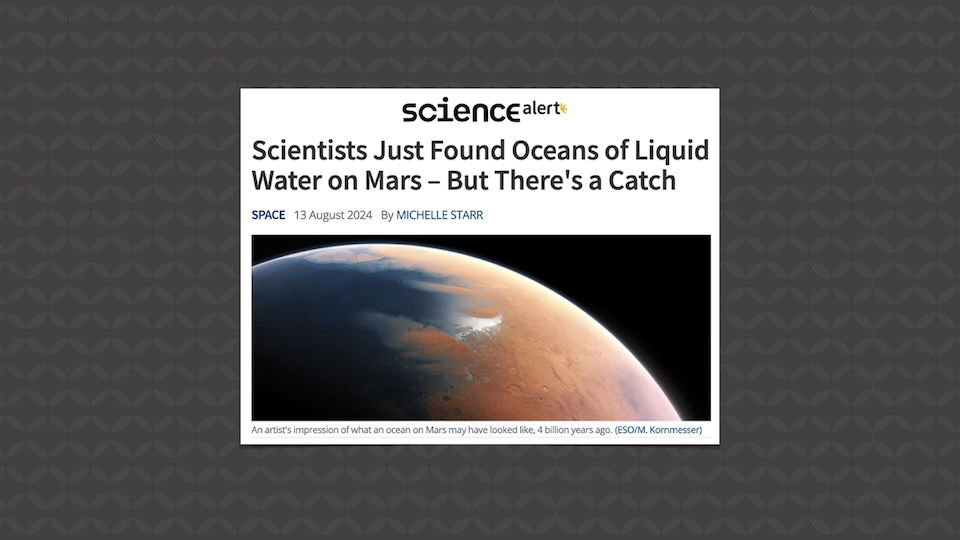
Oceans of Liquid Water On . . . Mars?
The word Mars conjures up an image of a red, dusty planet surrounded by the blackness of space. But many researchers believe Mars was once a watery world. What appears to be dry lake beds, river channels, and other geological features that look to be carved by water dot the surface. And researchers now believe they may know where some of the water disappeared to—the planet’s interior.
The now defunct InSight lander sat on the Martian surface for several years, relaying the “hums and rumbles of activity” under the surface back to researchers on earth. And scientists believe the best interpretation (and remember, it’s a fallible interpretation) of the acoustic data is that oceans of liquid water are hiding in the cracks of an igneous rock, such as granite (earth also has vast amounts of water below the crust). Now, this water is far below the surface, 7 to 12 miles below, so it is not accessible, but the researchers believe it might explain where at least some of the liquid water that once sculpted the Martian surface went (and, of course, they tie it into the search for life).
It never ceases to amaze me how so many scientists accept the possibility of vast amounts of water on Mars (either in the past or the present) and think that water is responsible for the geologic features found on the surface, including some features that appear to have been carved by a massive flood. But those same scientists outright reject the possibility of a global flood on earth—a planet covered in 70% water!
Now, a question we often hear isn’t “Where did the water on Mars go?” but “Where did the water after the flood go?” The answer is pretty simple—it’s still here! You see, the water in today’s oceans is the same water that covered the earth during the flood. Today’s geological features—mountains, valleys, canyons, deep sea trenches, etc.—didn’t exist before the flood. They were rapidly deposited, shaped, carved out, folded, and subducted because of catastrophic processes during the flood. One way we know this is because of the evidence they were deposited by water but also because they contain fossils buried during the flood.
Once you lower the mountains and raise the valleys and trenches, there’s more than enough water to cover the entire earth to the depth described in Genesis.
Once you lower the mountains and raise the valleys and trenches, there’s more than enough water to cover the entire earth to the depth described in Genesis.
Get More Answers on Answers News
This item was discussed Monday on Answers News with cohosts Dr. Tim Chaffey, Kevin Hadsall, and Dr. Gabriela Haynes. Answers News is our weekly news program filmed live before a studio audience here at the Creation Museum and posted to Answers TV. We also covered the following topics:
- A growing number of Americans support euthanasia.
- “Self-managed” abortions are growing.
- “Millions of years old” arch collapses in Utah.
- And more!
Be sure to watch this week’s episode of Answers News via the embedded video above or on our Answers TV streaming platform. You won’t want to miss this unique news program that gives science and culture news from a distinctly biblical and Christian perspective.
Thanks for stopping by and thanks for praying,
Ken
This item was written with the assistance of AiG’s research team.
Most Recent News
-
Jan. 11, 2026 from Ken Ham Blog
When was the last time your pastor addressed the issue of abortion and the sanctity of human life from the pulpit?
-
Jan. 10, 2026 from Ken Ham Blog
Answers in Genesis geneticist Dr. Nathaniel Jeanson recently revealed some of his findings on Mesoamerican peoples.

Answers in Genesis is an apologetics ministry, dedicated to helping Christians defend their faith and proclaim the good news of Jesus Christ.
- Customer Service 800.778.3390
- Available Monday–Friday | 9 AM–5 PM ET
- © 2026 Answers in Genesis



